Health Safety and Wellbeing in Health and Social Care Settings
VerifiedAdded on 2023/06/05
|11
|3045
|302
AI Summary
This study material covers legislation, policies, and procedures related to health and safety in health and social care settings. It also explains the principles of chain of infection and how to reduce the spread of infection. Additionally, it identifies different types of abuse and the actions to take when an individual is being abused. The subject is Health Safety and Wellbeing, and the course code and college/university are not mentioned.
Contribute Materials
Your contribution can guide someone’s learning journey. Share your
documents today.
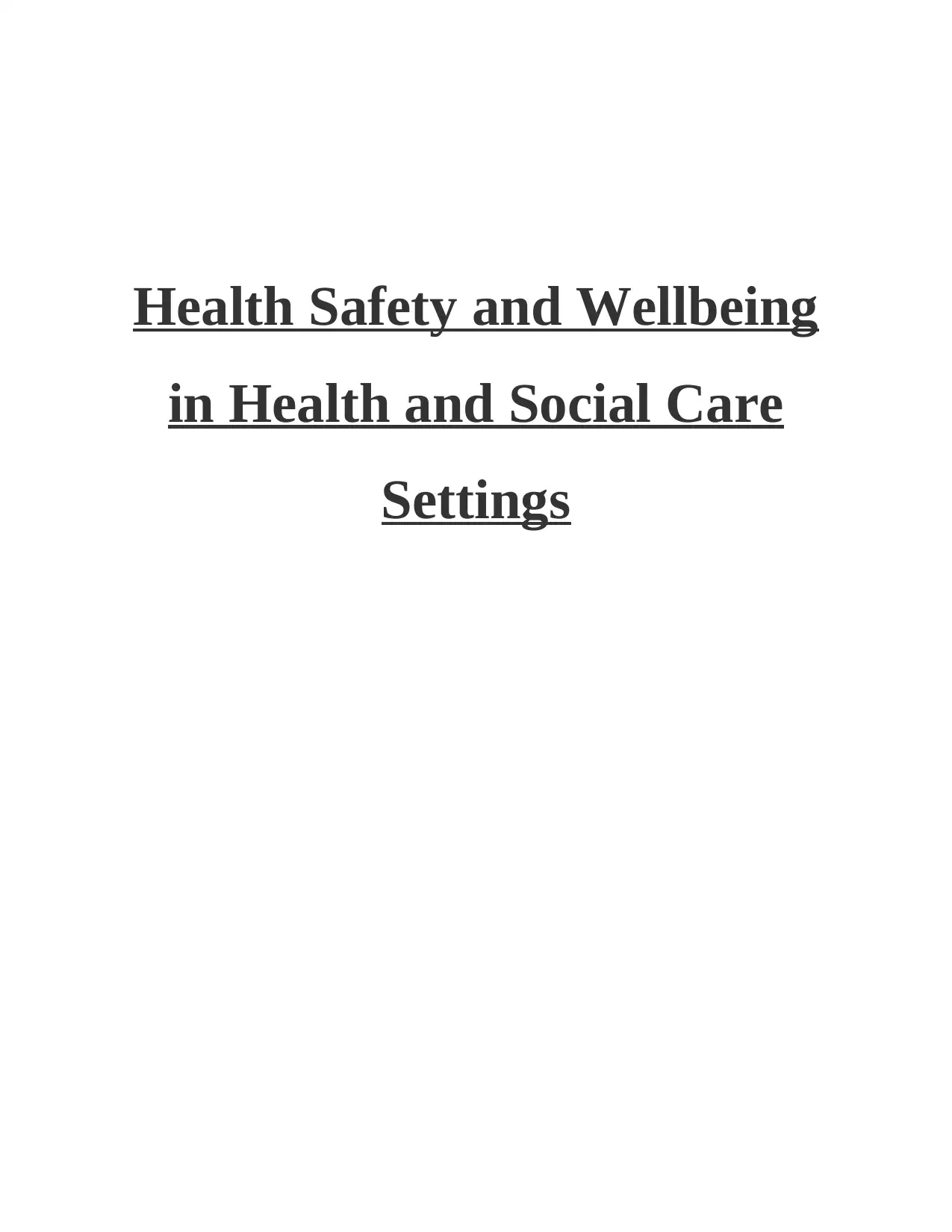
Health Safety and Wellbeing
in Health and Social Care
Settings
in Health and Social Care
Settings
Secure Best Marks with AI Grader
Need help grading? Try our AI Grader for instant feedback on your assignments.
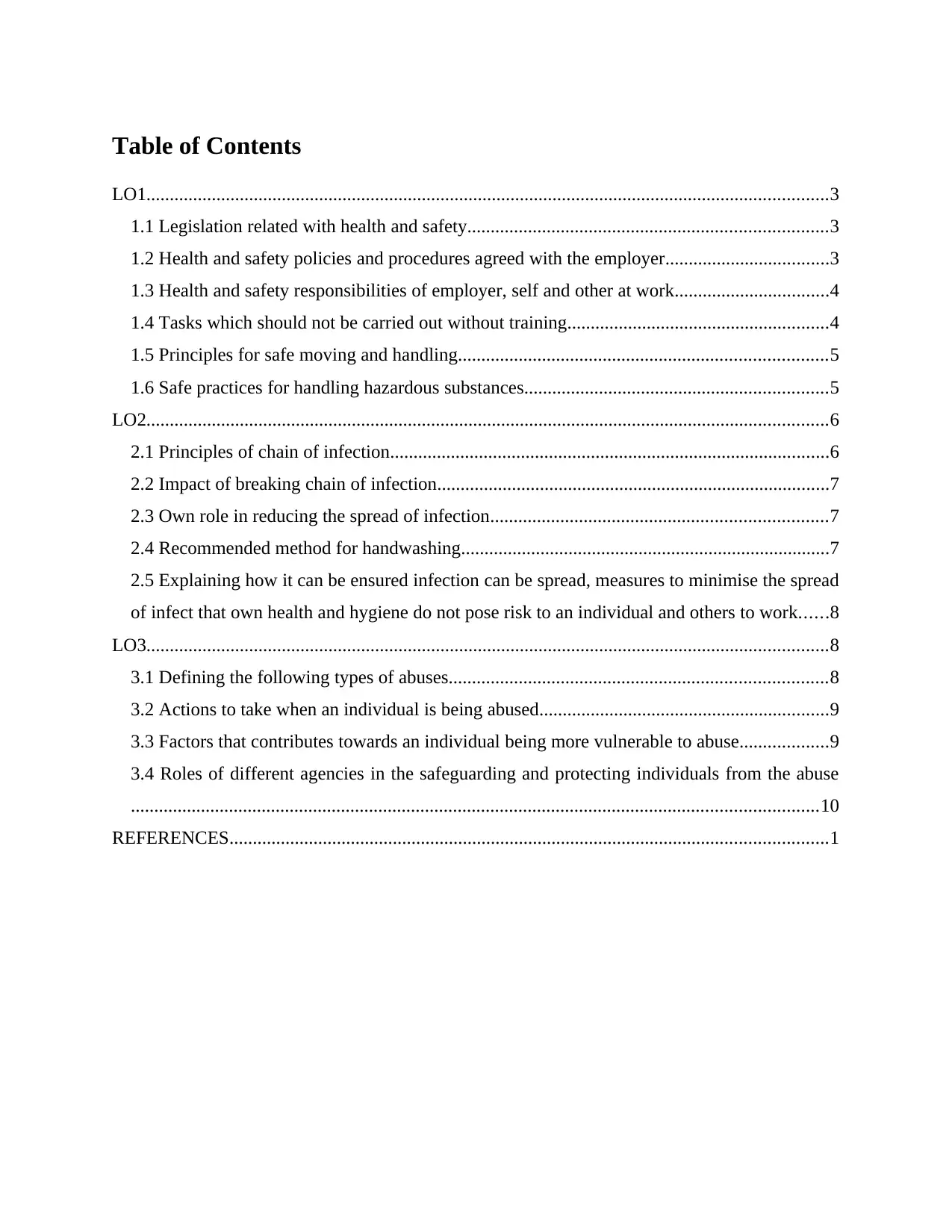
Table of Contents
LO1..................................................................................................................................................3
1.1 Legislation related with health and safety.............................................................................3
1.2 Health and safety policies and procedures agreed with the employer...................................3
1.3 Health and safety responsibilities of employer, self and other at work.................................4
1.4 Tasks which should not be carried out without training........................................................4
1.5 Principles for safe moving and handling...............................................................................5
1.6 Safe practices for handling hazardous substances.................................................................5
LO2..................................................................................................................................................6
2.1 Principles of chain of infection..............................................................................................6
2.2 Impact of breaking chain of infection....................................................................................7
2.3 Own role in reducing the spread of infection........................................................................7
2.4 Recommended method for handwashing...............................................................................7
2.5 Explaining how it can be ensured infection can be spread, measures to minimise the spread
of infect that own health and hygiene do not pose risk to an individual and others to work......8
LO3..................................................................................................................................................8
3.1 Defining the following types of abuses.................................................................................8
3.2 Actions to take when an individual is being abused..............................................................9
3.3 Factors that contributes towards an individual being more vulnerable to abuse...................9
3.4 Roles of different agencies in the safeguarding and protecting individuals from the abuse
...................................................................................................................................................10
REFERENCES................................................................................................................................1
LO1..................................................................................................................................................3
1.1 Legislation related with health and safety.............................................................................3
1.2 Health and safety policies and procedures agreed with the employer...................................3
1.3 Health and safety responsibilities of employer, self and other at work.................................4
1.4 Tasks which should not be carried out without training........................................................4
1.5 Principles for safe moving and handling...............................................................................5
1.6 Safe practices for handling hazardous substances.................................................................5
LO2..................................................................................................................................................6
2.1 Principles of chain of infection..............................................................................................6
2.2 Impact of breaking chain of infection....................................................................................7
2.3 Own role in reducing the spread of infection........................................................................7
2.4 Recommended method for handwashing...............................................................................7
2.5 Explaining how it can be ensured infection can be spread, measures to minimise the spread
of infect that own health and hygiene do not pose risk to an individual and others to work......8
LO3..................................................................................................................................................8
3.1 Defining the following types of abuses.................................................................................8
3.2 Actions to take when an individual is being abused..............................................................9
3.3 Factors that contributes towards an individual being more vulnerable to abuse...................9
3.4 Roles of different agencies in the safeguarding and protecting individuals from the abuse
...................................................................................................................................................10
REFERENCES................................................................................................................................1
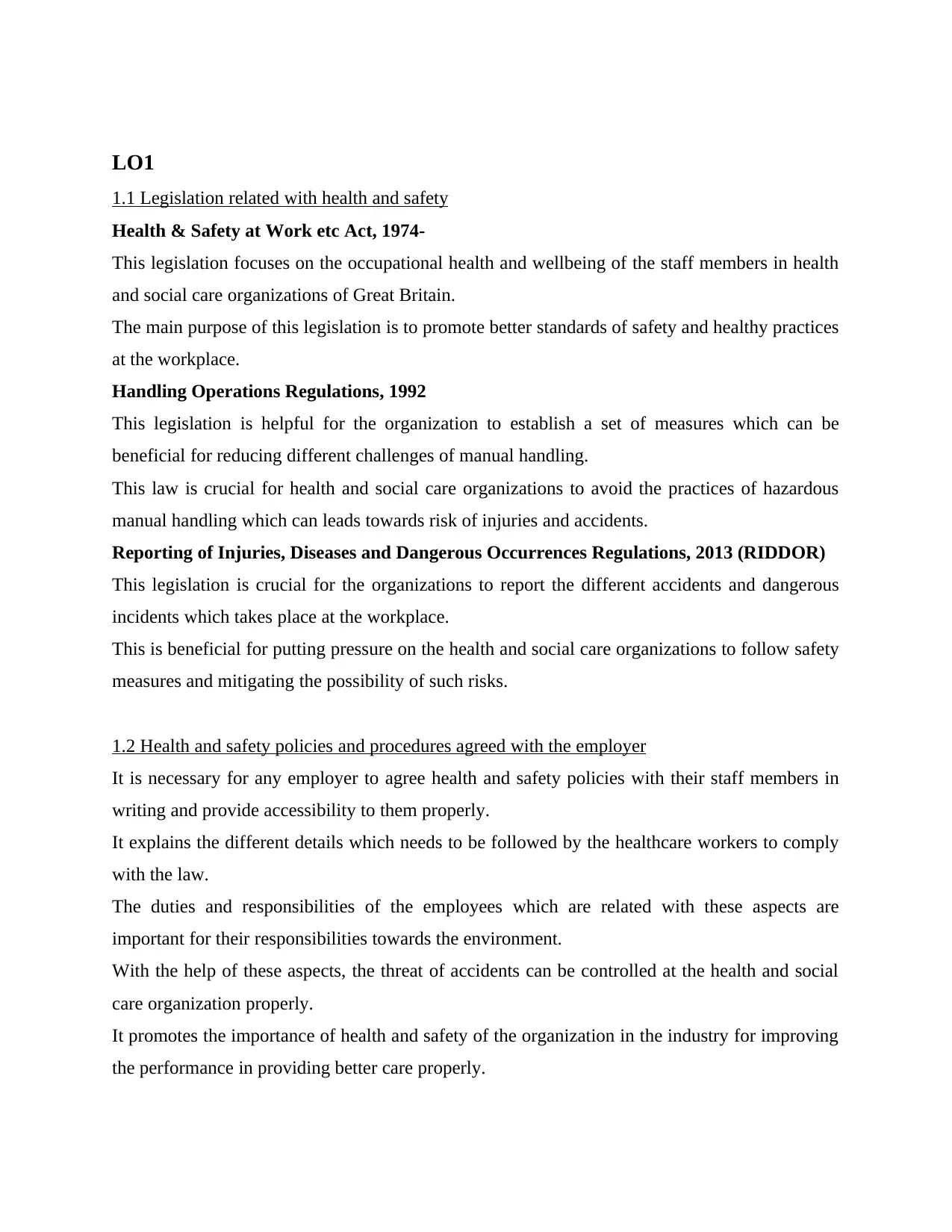
LO1
1.1 Legislation related with health and safety
Health & Safety at Work etc Act, 1974-
This legislation focuses on the occupational health and wellbeing of the staff members in health
and social care organizations of Great Britain.
The main purpose of this legislation is to promote better standards of safety and healthy practices
at the workplace.
Handling Operations Regulations, 1992
This legislation is helpful for the organization to establish a set of measures which can be
beneficial for reducing different challenges of manual handling.
This law is crucial for health and social care organizations to avoid the practices of hazardous
manual handling which can leads towards risk of injuries and accidents.
Reporting of Injuries, Diseases and Dangerous Occurrences Regulations, 2013 (RIDDOR)
This legislation is crucial for the organizations to report the different accidents and dangerous
incidents which takes place at the workplace.
This is beneficial for putting pressure on the health and social care organizations to follow safety
measures and mitigating the possibility of such risks.
1.2 Health and safety policies and procedures agreed with the employer
It is necessary for any employer to agree health and safety policies with their staff members in
writing and provide accessibility to them properly.
It explains the different details which needs to be followed by the healthcare workers to comply
with the law.
The duties and responsibilities of the employees which are related with these aspects are
important for their responsibilities towards the environment.
With the help of these aspects, the threat of accidents can be controlled at the health and social
care organization properly.
It promotes the importance of health and safety of the organization in the industry for improving
the performance in providing better care properly.
1.1 Legislation related with health and safety
Health & Safety at Work etc Act, 1974-
This legislation focuses on the occupational health and wellbeing of the staff members in health
and social care organizations of Great Britain.
The main purpose of this legislation is to promote better standards of safety and healthy practices
at the workplace.
Handling Operations Regulations, 1992
This legislation is helpful for the organization to establish a set of measures which can be
beneficial for reducing different challenges of manual handling.
This law is crucial for health and social care organizations to avoid the practices of hazardous
manual handling which can leads towards risk of injuries and accidents.
Reporting of Injuries, Diseases and Dangerous Occurrences Regulations, 2013 (RIDDOR)
This legislation is crucial for the organizations to report the different accidents and dangerous
incidents which takes place at the workplace.
This is beneficial for putting pressure on the health and social care organizations to follow safety
measures and mitigating the possibility of such risks.
1.2 Health and safety policies and procedures agreed with the employer
It is necessary for any employer to agree health and safety policies with their staff members in
writing and provide accessibility to them properly.
It explains the different details which needs to be followed by the healthcare workers to comply
with the law.
The duties and responsibilities of the employees which are related with these aspects are
important for their responsibilities towards the environment.
With the help of these aspects, the threat of accidents can be controlled at the health and social
care organization properly.
It promotes the importance of health and safety of the organization in the industry for improving
the performance in providing better care properly.
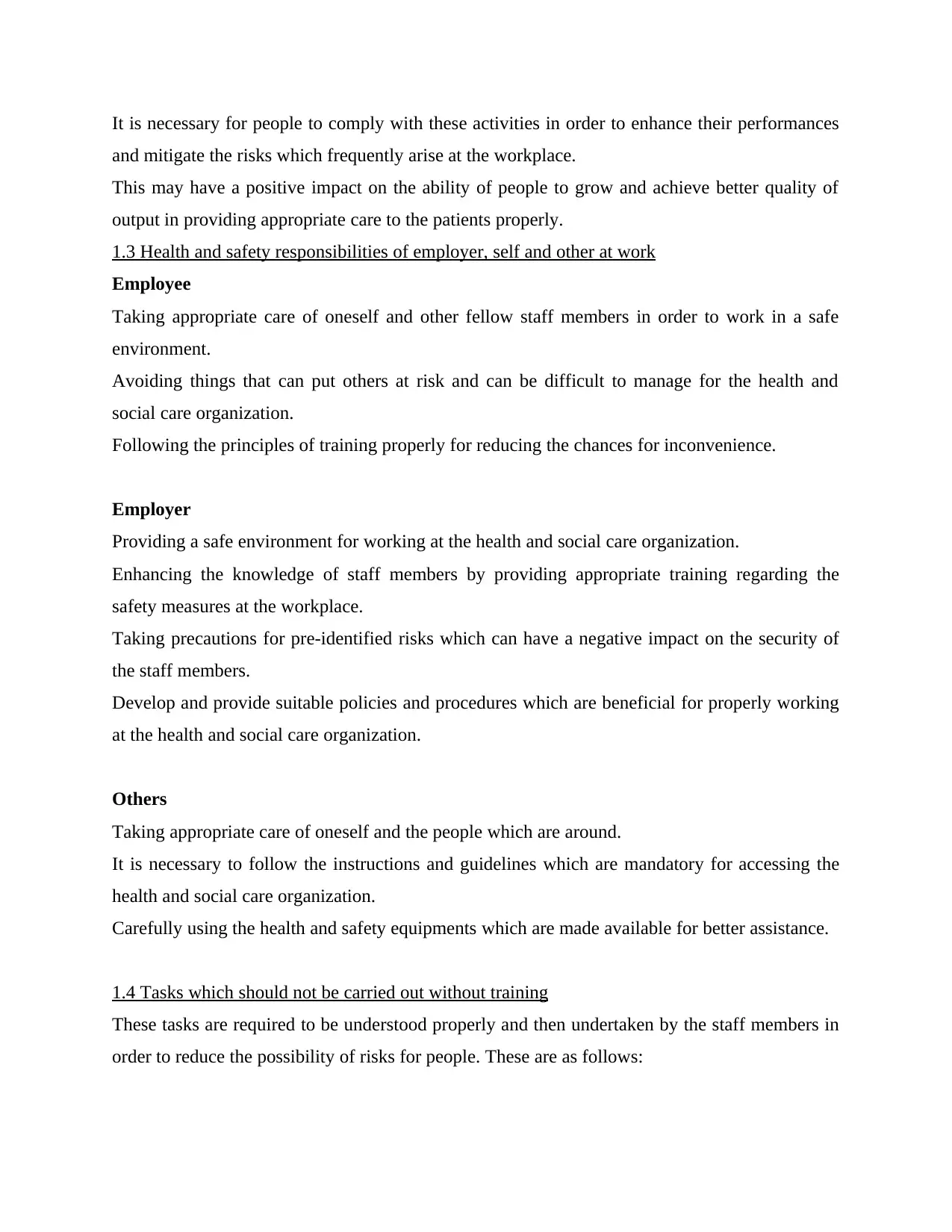
It is necessary for people to comply with these activities in order to enhance their performances
and mitigate the risks which frequently arise at the workplace.
This may have a positive impact on the ability of people to grow and achieve better quality of
output in providing appropriate care to the patients properly.
1.3 Health and safety responsibilities of employer, self and other at work
Employee
Taking appropriate care of oneself and other fellow staff members in order to work in a safe
environment.
Avoiding things that can put others at risk and can be difficult to manage for the health and
social care organization.
Following the principles of training properly for reducing the chances for inconvenience.
Employer
Providing a safe environment for working at the health and social care organization.
Enhancing the knowledge of staff members by providing appropriate training regarding the
safety measures at the workplace.
Taking precautions for pre-identified risks which can have a negative impact on the security of
the staff members.
Develop and provide suitable policies and procedures which are beneficial for properly working
at the health and social care organization.
Others
Taking appropriate care of oneself and the people which are around.
It is necessary to follow the instructions and guidelines which are mandatory for accessing the
health and social care organization.
Carefully using the health and safety equipments which are made available for better assistance.
1.4 Tasks which should not be carried out without training
These tasks are required to be understood properly and then undertaken by the staff members in
order to reduce the possibility of risks for people. These are as follows:
and mitigate the risks which frequently arise at the workplace.
This may have a positive impact on the ability of people to grow and achieve better quality of
output in providing appropriate care to the patients properly.
1.3 Health and safety responsibilities of employer, self and other at work
Employee
Taking appropriate care of oneself and other fellow staff members in order to work in a safe
environment.
Avoiding things that can put others at risk and can be difficult to manage for the health and
social care organization.
Following the principles of training properly for reducing the chances for inconvenience.
Employer
Providing a safe environment for working at the health and social care organization.
Enhancing the knowledge of staff members by providing appropriate training regarding the
safety measures at the workplace.
Taking precautions for pre-identified risks which can have a negative impact on the security of
the staff members.
Develop and provide suitable policies and procedures which are beneficial for properly working
at the health and social care organization.
Others
Taking appropriate care of oneself and the people which are around.
It is necessary to follow the instructions and guidelines which are mandatory for accessing the
health and social care organization.
Carefully using the health and safety equipments which are made available for better assistance.
1.4 Tasks which should not be carried out without training
These tasks are required to be understood properly and then undertaken by the staff members in
order to reduce the possibility of risks for people. These are as follows:
Paraphrase This Document
Need a fresh take? Get an instant paraphrase of this document with our AI Paraphraser
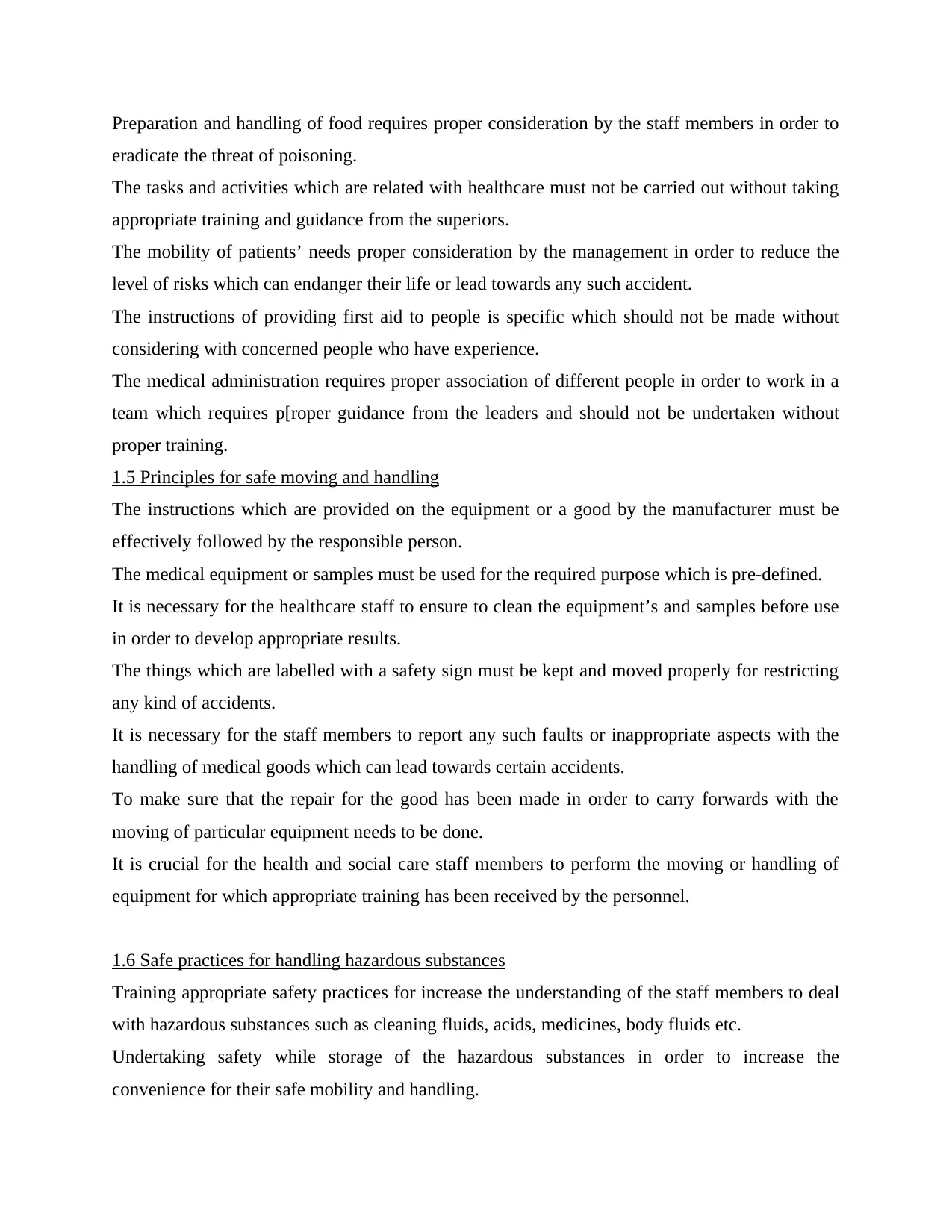
Preparation and handling of food requires proper consideration by the staff members in order to
eradicate the threat of poisoning.
The tasks and activities which are related with healthcare must not be carried out without taking
appropriate training and guidance from the superiors.
The mobility of patients’ needs proper consideration by the management in order to reduce the
level of risks which can endanger their life or lead towards any such accident.
The instructions of providing first aid to people is specific which should not be made without
considering with concerned people who have experience.
The medical administration requires proper association of different people in order to work in a
team which requires p[roper guidance from the leaders and should not be undertaken without
proper training.
1.5 Principles for safe moving and handling
The instructions which are provided on the equipment or a good by the manufacturer must be
effectively followed by the responsible person.
The medical equipment or samples must be used for the required purpose which is pre-defined.
It is necessary for the healthcare staff to ensure to clean the equipment’s and samples before use
in order to develop appropriate results.
The things which are labelled with a safety sign must be kept and moved properly for restricting
any kind of accidents.
It is necessary for the staff members to report any such faults or inappropriate aspects with the
handling of medical goods which can lead towards certain accidents.
To make sure that the repair for the good has been made in order to carry forwards with the
moving of particular equipment needs to be done.
It is crucial for the health and social care staff members to perform the moving or handling of
equipment for which appropriate training has been received by the personnel.
1.6 Safe practices for handling hazardous substances
Training appropriate safety practices for increase the understanding of the staff members to deal
with hazardous substances such as cleaning fluids, acids, medicines, body fluids etc.
Undertaking safety while storage of the hazardous substances in order to increase the
convenience for their safe mobility and handling.
eradicate the threat of poisoning.
The tasks and activities which are related with healthcare must not be carried out without taking
appropriate training and guidance from the superiors.
The mobility of patients’ needs proper consideration by the management in order to reduce the
level of risks which can endanger their life or lead towards any such accident.
The instructions of providing first aid to people is specific which should not be made without
considering with concerned people who have experience.
The medical administration requires proper association of different people in order to work in a
team which requires p[roper guidance from the leaders and should not be undertaken without
proper training.
1.5 Principles for safe moving and handling
The instructions which are provided on the equipment or a good by the manufacturer must be
effectively followed by the responsible person.
The medical equipment or samples must be used for the required purpose which is pre-defined.
It is necessary for the healthcare staff to ensure to clean the equipment’s and samples before use
in order to develop appropriate results.
The things which are labelled with a safety sign must be kept and moved properly for restricting
any kind of accidents.
It is necessary for the staff members to report any such faults or inappropriate aspects with the
handling of medical goods which can lead towards certain accidents.
To make sure that the repair for the good has been made in order to carry forwards with the
moving of particular equipment needs to be done.
It is crucial for the health and social care staff members to perform the moving or handling of
equipment for which appropriate training has been received by the personnel.
1.6 Safe practices for handling hazardous substances
Training appropriate safety practices for increase the understanding of the staff members to deal
with hazardous substances such as cleaning fluids, acids, medicines, body fluids etc.
Undertaking safety while storage of the hazardous substances in order to increase the
convenience for their safe mobility and handling.

Following the policies and procedures which are mentioned on the hazardous substances that
have a warning sign.
Using high quality containers which can withhold the chemicals or liquids which have high
tendency to create a negative impact on the staff member who is handling it.
It is necessary for the staff member to maintain appropriate distance from the hazardous
substances and restrict the factors like inhalation of any such gages which can be hazardous for
them.
The disposal of these materials must be appropriately made in order to reduce the risk of expose
of the hazardous contaminants in the environment.
LO2
2.1 Principles of chain of infection
Infectious agent
It is necessary for the healthcare staff to identify the different germs and infecting agents which
are the main cause for any disease.
This is helpful for understanding the issues at the basic level and prepare appropriate practices
for mitigation of the risks.
Reservoir
This includes the different places where these pathogens exist and develop the ability to
contaminate the environment.
The places where different medical equipment, insects, soil or water may get these contaminants
that increases the infection.
Portal of exit
This is referred as the method where infectious agent leaves the reservoir having a negative
impact on the patients.
These portals are aerosols, open wounds, coughing, saliva etc. which increases the chances of
infection among the patients.
Means of transmission
These are the different ways through which infection can be passed on to the patient increasing
the chances of diseases to them.
This can be identified such as ingestion, direct contact or inhalation of any such hazardous
substance which has a negative influence on the patient.
have a warning sign.
Using high quality containers which can withhold the chemicals or liquids which have high
tendency to create a negative impact on the staff member who is handling it.
It is necessary for the staff member to maintain appropriate distance from the hazardous
substances and restrict the factors like inhalation of any such gages which can be hazardous for
them.
The disposal of these materials must be appropriately made in order to reduce the risk of expose
of the hazardous contaminants in the environment.
LO2
2.1 Principles of chain of infection
Infectious agent
It is necessary for the healthcare staff to identify the different germs and infecting agents which
are the main cause for any disease.
This is helpful for understanding the issues at the basic level and prepare appropriate practices
for mitigation of the risks.
Reservoir
This includes the different places where these pathogens exist and develop the ability to
contaminate the environment.
The places where different medical equipment, insects, soil or water may get these contaminants
that increases the infection.
Portal of exit
This is referred as the method where infectious agent leaves the reservoir having a negative
impact on the patients.
These portals are aerosols, open wounds, coughing, saliva etc. which increases the chances of
infection among the patients.
Means of transmission
These are the different ways through which infection can be passed on to the patient increasing
the chances of diseases to them.
This can be identified such as ingestion, direct contact or inhalation of any such hazardous
substance which has a negative influence on the patient.
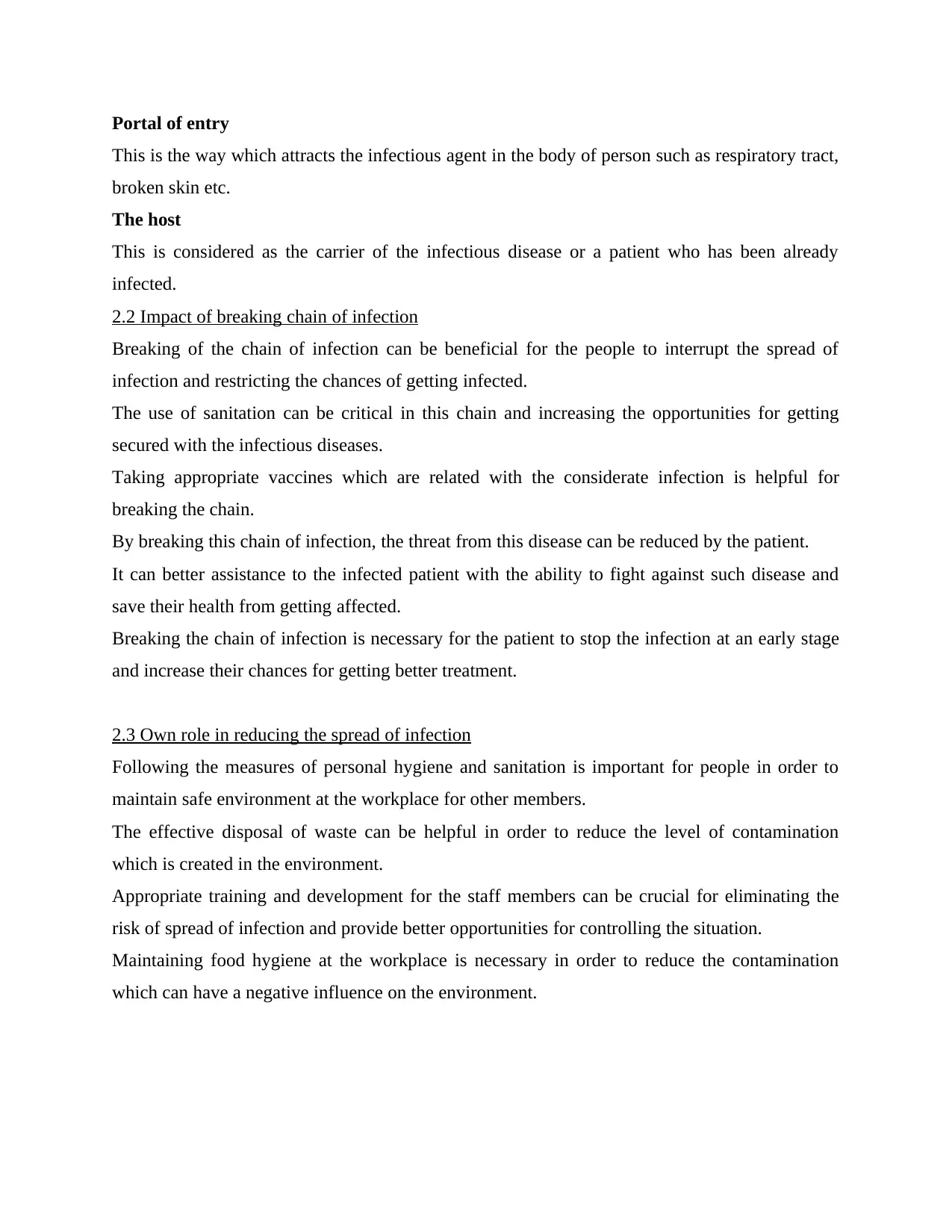
Portal of entry
This is the way which attracts the infectious agent in the body of person such as respiratory tract,
broken skin etc.
The host
This is considered as the carrier of the infectious disease or a patient who has been already
infected.
2.2 Impact of breaking chain of infection
Breaking of the chain of infection can be beneficial for the people to interrupt the spread of
infection and restricting the chances of getting infected.
The use of sanitation can be critical in this chain and increasing the opportunities for getting
secured with the infectious diseases.
Taking appropriate vaccines which are related with the considerate infection is helpful for
breaking the chain.
By breaking this chain of infection, the threat from this disease can be reduced by the patient.
It can better assistance to the infected patient with the ability to fight against such disease and
save their health from getting affected.
Breaking the chain of infection is necessary for the patient to stop the infection at an early stage
and increase their chances for getting better treatment.
2.3 Own role in reducing the spread of infection
Following the measures of personal hygiene and sanitation is important for people in order to
maintain safe environment at the workplace for other members.
The effective disposal of waste can be helpful in order to reduce the level of contamination
which is created in the environment.
Appropriate training and development for the staff members can be crucial for eliminating the
risk of spread of infection and provide better opportunities for controlling the situation.
Maintaining food hygiene at the workplace is necessary in order to reduce the contamination
which can have a negative influence on the environment.
This is the way which attracts the infectious agent in the body of person such as respiratory tract,
broken skin etc.
The host
This is considered as the carrier of the infectious disease or a patient who has been already
infected.
2.2 Impact of breaking chain of infection
Breaking of the chain of infection can be beneficial for the people to interrupt the spread of
infection and restricting the chances of getting infected.
The use of sanitation can be critical in this chain and increasing the opportunities for getting
secured with the infectious diseases.
Taking appropriate vaccines which are related with the considerate infection is helpful for
breaking the chain.
By breaking this chain of infection, the threat from this disease can be reduced by the patient.
It can better assistance to the infected patient with the ability to fight against such disease and
save their health from getting affected.
Breaking the chain of infection is necessary for the patient to stop the infection at an early stage
and increase their chances for getting better treatment.
2.3 Own role in reducing the spread of infection
Following the measures of personal hygiene and sanitation is important for people in order to
maintain safe environment at the workplace for other members.
The effective disposal of waste can be helpful in order to reduce the level of contamination
which is created in the environment.
Appropriate training and development for the staff members can be crucial for eliminating the
risk of spread of infection and provide better opportunities for controlling the situation.
Maintaining food hygiene at the workplace is necessary in order to reduce the contamination
which can have a negative influence on the environment.
Secure Best Marks with AI Grader
Need help grading? Try our AI Grader for instant feedback on your assignments.
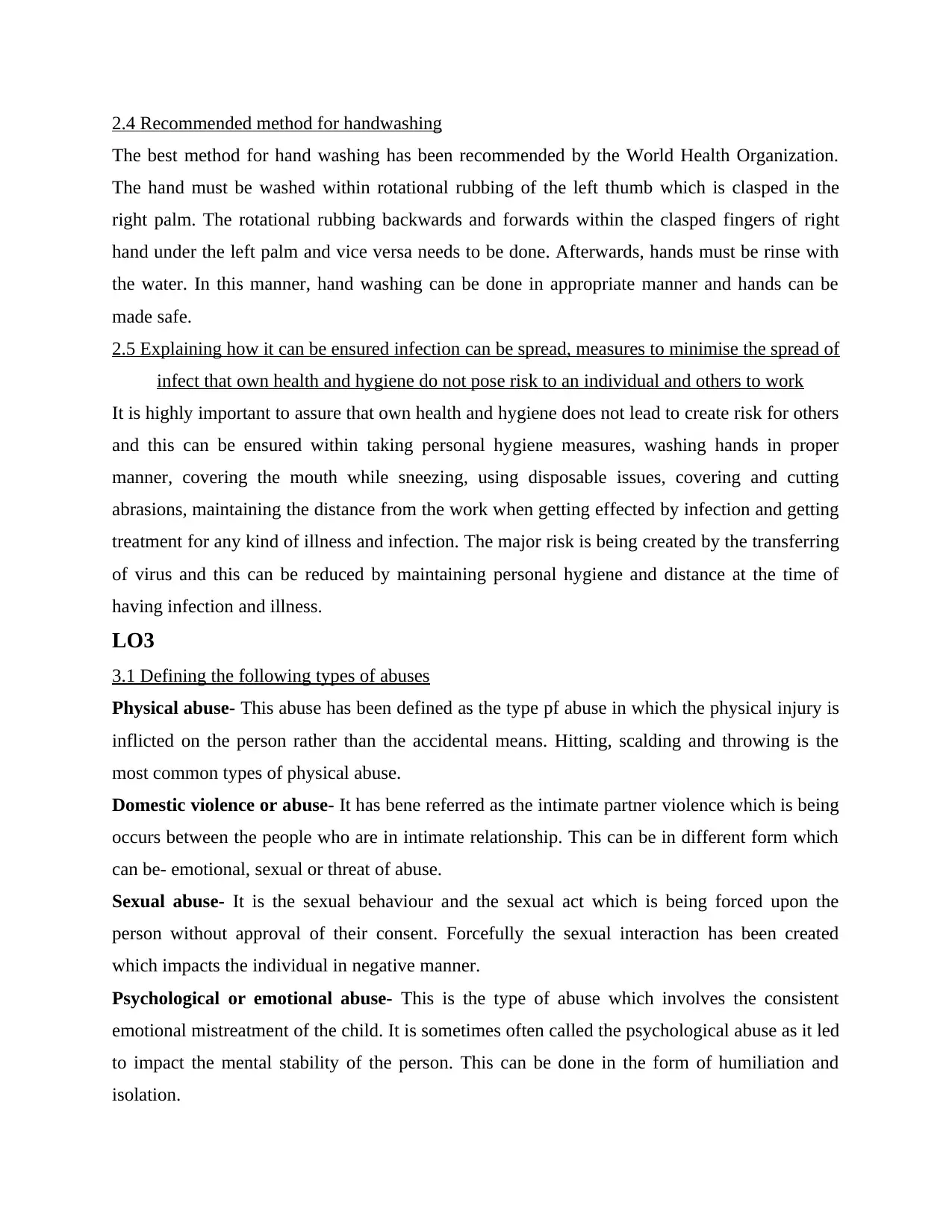
2.4 Recommended method for handwashing
The best method for hand washing has been recommended by the World Health Organization.
The hand must be washed within rotational rubbing of the left thumb which is clasped in the
right palm. The rotational rubbing backwards and forwards within the clasped fingers of right
hand under the left palm and vice versa needs to be done. Afterwards, hands must be rinse with
the water. In this manner, hand washing can be done in appropriate manner and hands can be
made safe.
2.5 Explaining how it can be ensured infection can be spread, measures to minimise the spread of
infect that own health and hygiene do not pose risk to an individual and others to work
It is highly important to assure that own health and hygiene does not lead to create risk for others
and this can be ensured within taking personal hygiene measures, washing hands in proper
manner, covering the mouth while sneezing, using disposable issues, covering and cutting
abrasions, maintaining the distance from the work when getting effected by infection and getting
treatment for any kind of illness and infection. The major risk is being created by the transferring
of virus and this can be reduced by maintaining personal hygiene and distance at the time of
having infection and illness.
LO3
3.1 Defining the following types of abuses
Physical abuse- This abuse has been defined as the type pf abuse in which the physical injury is
inflicted on the person rather than the accidental means. Hitting, scalding and throwing is the
most common types of physical abuse.
Domestic violence or abuse- It has bene referred as the intimate partner violence which is being
occurs between the people who are in intimate relationship. This can be in different form which
can be- emotional, sexual or threat of abuse.
Sexual abuse- It is the sexual behaviour and the sexual act which is being forced upon the
person without approval of their consent. Forcefully the sexual interaction has been created
which impacts the individual in negative manner.
Psychological or emotional abuse- This is the type of abuse which involves the consistent
emotional mistreatment of the child. It is sometimes often called the psychological abuse as it led
to impact the mental stability of the person. This can be done in the form of humiliation and
isolation.
The best method for hand washing has been recommended by the World Health Organization.
The hand must be washed within rotational rubbing of the left thumb which is clasped in the
right palm. The rotational rubbing backwards and forwards within the clasped fingers of right
hand under the left palm and vice versa needs to be done. Afterwards, hands must be rinse with
the water. In this manner, hand washing can be done in appropriate manner and hands can be
made safe.
2.5 Explaining how it can be ensured infection can be spread, measures to minimise the spread of
infect that own health and hygiene do not pose risk to an individual and others to work
It is highly important to assure that own health and hygiene does not lead to create risk for others
and this can be ensured within taking personal hygiene measures, washing hands in proper
manner, covering the mouth while sneezing, using disposable issues, covering and cutting
abrasions, maintaining the distance from the work when getting effected by infection and getting
treatment for any kind of illness and infection. The major risk is being created by the transferring
of virus and this can be reduced by maintaining personal hygiene and distance at the time of
having infection and illness.
LO3
3.1 Defining the following types of abuses
Physical abuse- This abuse has been defined as the type pf abuse in which the physical injury is
inflicted on the person rather than the accidental means. Hitting, scalding and throwing is the
most common types of physical abuse.
Domestic violence or abuse- It has bene referred as the intimate partner violence which is being
occurs between the people who are in intimate relationship. This can be in different form which
can be- emotional, sexual or threat of abuse.
Sexual abuse- It is the sexual behaviour and the sexual act which is being forced upon the
person without approval of their consent. Forcefully the sexual interaction has been created
which impacts the individual in negative manner.
Psychological or emotional abuse- This is the type of abuse which involves the consistent
emotional mistreatment of the child. It is sometimes often called the psychological abuse as it led
to impact the mental stability of the person. This can be done in the form of humiliation and
isolation.
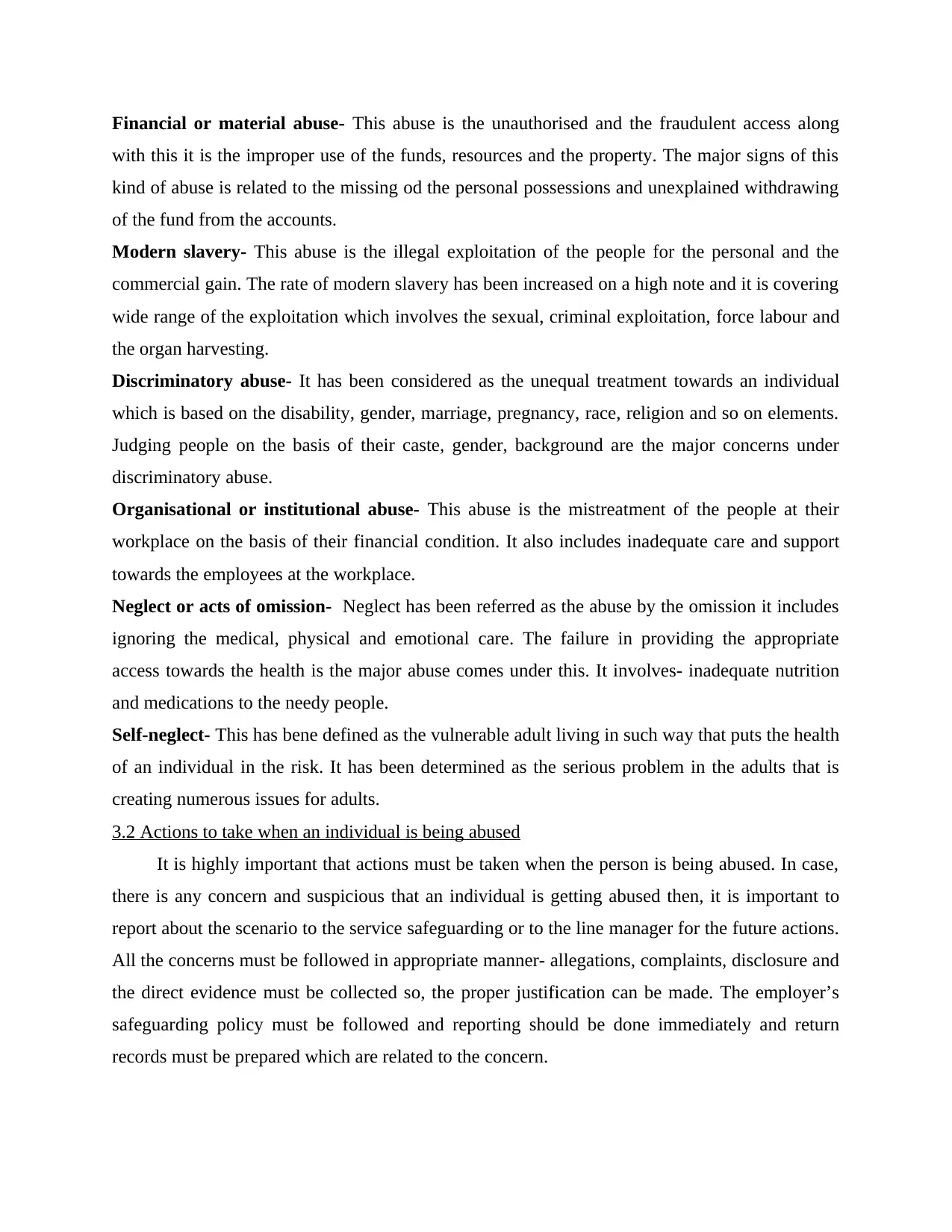
Financial or material abuse- This abuse is the unauthorised and the fraudulent access along
with this it is the improper use of the funds, resources and the property. The major signs of this
kind of abuse is related to the missing od the personal possessions and unexplained withdrawing
of the fund from the accounts.
Modern slavery- This abuse is the illegal exploitation of the people for the personal and the
commercial gain. The rate of modern slavery has been increased on a high note and it is covering
wide range of the exploitation which involves the sexual, criminal exploitation, force labour and
the organ harvesting.
Discriminatory abuse- It has been considered as the unequal treatment towards an individual
which is based on the disability, gender, marriage, pregnancy, race, religion and so on elements.
Judging people on the basis of their caste, gender, background are the major concerns under
discriminatory abuse.
Organisational or institutional abuse- This abuse is the mistreatment of the people at their
workplace on the basis of their financial condition. It also includes inadequate care and support
towards the employees at the workplace.
Neglect or acts of omission- Neglect has been referred as the abuse by the omission it includes
ignoring the medical, physical and emotional care. The failure in providing the appropriate
access towards the health is the major abuse comes under this. It involves- inadequate nutrition
and medications to the needy people.
Self-neglect- This has bene defined as the vulnerable adult living in such way that puts the health
of an individual in the risk. It has been determined as the serious problem in the adults that is
creating numerous issues for adults.
3.2 Actions to take when an individual is being abused
It is highly important that actions must be taken when the person is being abused. In case,
there is any concern and suspicious that an individual is getting abused then, it is important to
report about the scenario to the service safeguarding or to the line manager for the future actions.
All the concerns must be followed in appropriate manner- allegations, complaints, disclosure and
the direct evidence must be collected so, the proper justification can be made. The employer’s
safeguarding policy must be followed and reporting should be done immediately and return
records must be prepared which are related to the concern.
with this it is the improper use of the funds, resources and the property. The major signs of this
kind of abuse is related to the missing od the personal possessions and unexplained withdrawing
of the fund from the accounts.
Modern slavery- This abuse is the illegal exploitation of the people for the personal and the
commercial gain. The rate of modern slavery has been increased on a high note and it is covering
wide range of the exploitation which involves the sexual, criminal exploitation, force labour and
the organ harvesting.
Discriminatory abuse- It has been considered as the unequal treatment towards an individual
which is based on the disability, gender, marriage, pregnancy, race, religion and so on elements.
Judging people on the basis of their caste, gender, background are the major concerns under
discriminatory abuse.
Organisational or institutional abuse- This abuse is the mistreatment of the people at their
workplace on the basis of their financial condition. It also includes inadequate care and support
towards the employees at the workplace.
Neglect or acts of omission- Neglect has been referred as the abuse by the omission it includes
ignoring the medical, physical and emotional care. The failure in providing the appropriate
access towards the health is the major abuse comes under this. It involves- inadequate nutrition
and medications to the needy people.
Self-neglect- This has bene defined as the vulnerable adult living in such way that puts the health
of an individual in the risk. It has been determined as the serious problem in the adults that is
creating numerous issues for adults.
3.2 Actions to take when an individual is being abused
It is highly important that actions must be taken when the person is being abused. In case,
there is any concern and suspicious that an individual is getting abused then, it is important to
report about the scenario to the service safeguarding or to the line manager for the future actions.
All the concerns must be followed in appropriate manner- allegations, complaints, disclosure and
the direct evidence must be collected so, the proper justification can be made. The employer’s
safeguarding policy must be followed and reporting should be done immediately and return
records must be prepared which are related to the concern.
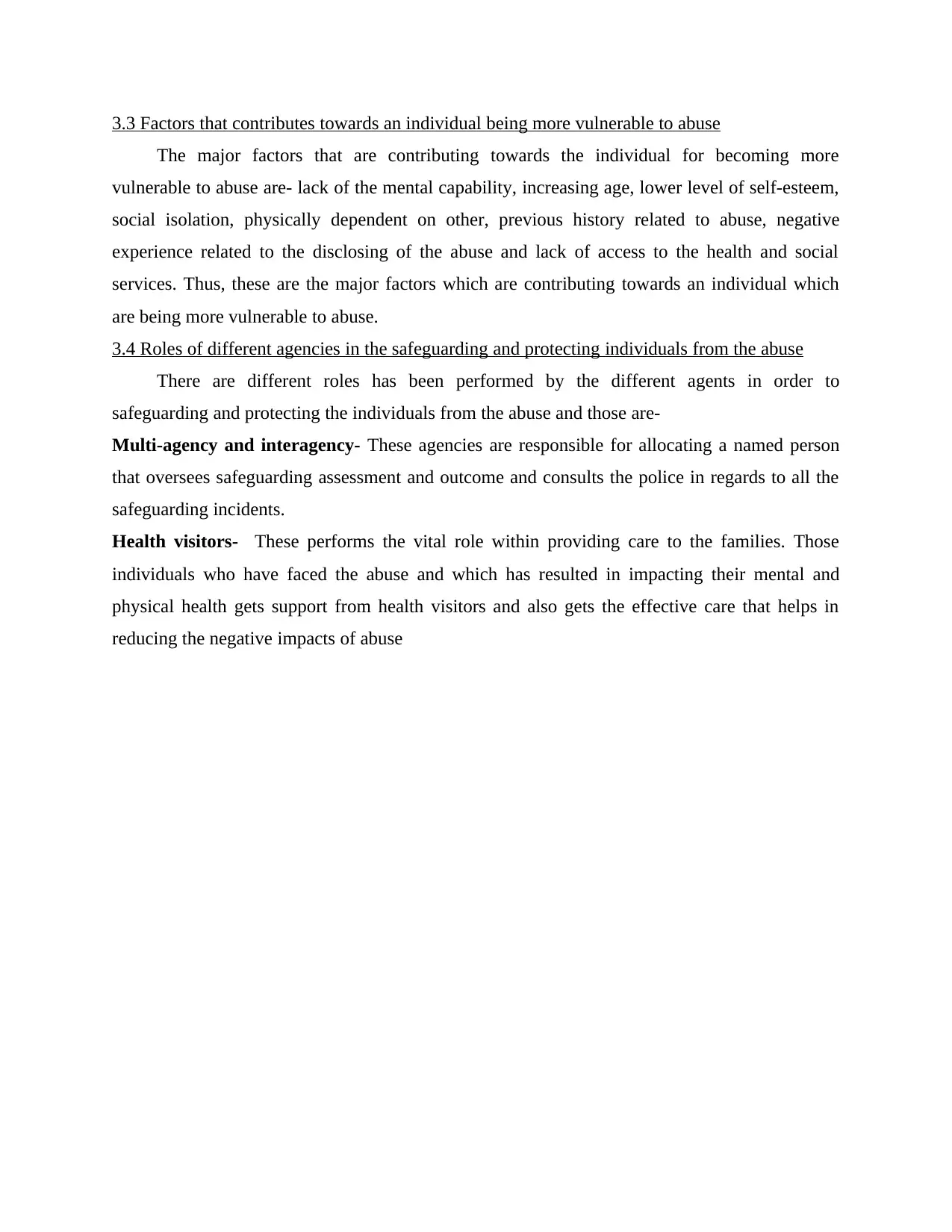
3.3 Factors that contributes towards an individual being more vulnerable to abuse
The major factors that are contributing towards the individual for becoming more
vulnerable to abuse are- lack of the mental capability, increasing age, lower level of self-esteem,
social isolation, physically dependent on other, previous history related to abuse, negative
experience related to the disclosing of the abuse and lack of access to the health and social
services. Thus, these are the major factors which are contributing towards an individual which
are being more vulnerable to abuse.
3.4 Roles of different agencies in the safeguarding and protecting individuals from the abuse
There are different roles has been performed by the different agents in order to
safeguarding and protecting the individuals from the abuse and those are-
Multi-agency and interagency- These agencies are responsible for allocating a named person
that oversees safeguarding assessment and outcome and consults the police in regards to all the
safeguarding incidents.
Health visitors- These performs the vital role within providing care to the families. Those
individuals who have faced the abuse and which has resulted in impacting their mental and
physical health gets support from health visitors and also gets the effective care that helps in
reducing the negative impacts of abuse
The major factors that are contributing towards the individual for becoming more
vulnerable to abuse are- lack of the mental capability, increasing age, lower level of self-esteem,
social isolation, physically dependent on other, previous history related to abuse, negative
experience related to the disclosing of the abuse and lack of access to the health and social
services. Thus, these are the major factors which are contributing towards an individual which
are being more vulnerable to abuse.
3.4 Roles of different agencies in the safeguarding and protecting individuals from the abuse
There are different roles has been performed by the different agents in order to
safeguarding and protecting the individuals from the abuse and those are-
Multi-agency and interagency- These agencies are responsible for allocating a named person
that oversees safeguarding assessment and outcome and consults the police in regards to all the
safeguarding incidents.
Health visitors- These performs the vital role within providing care to the families. Those
individuals who have faced the abuse and which has resulted in impacting their mental and
physical health gets support from health visitors and also gets the effective care that helps in
reducing the negative impacts of abuse
Paraphrase This Document
Need a fresh take? Get an instant paraphrase of this document with our AI Paraphraser
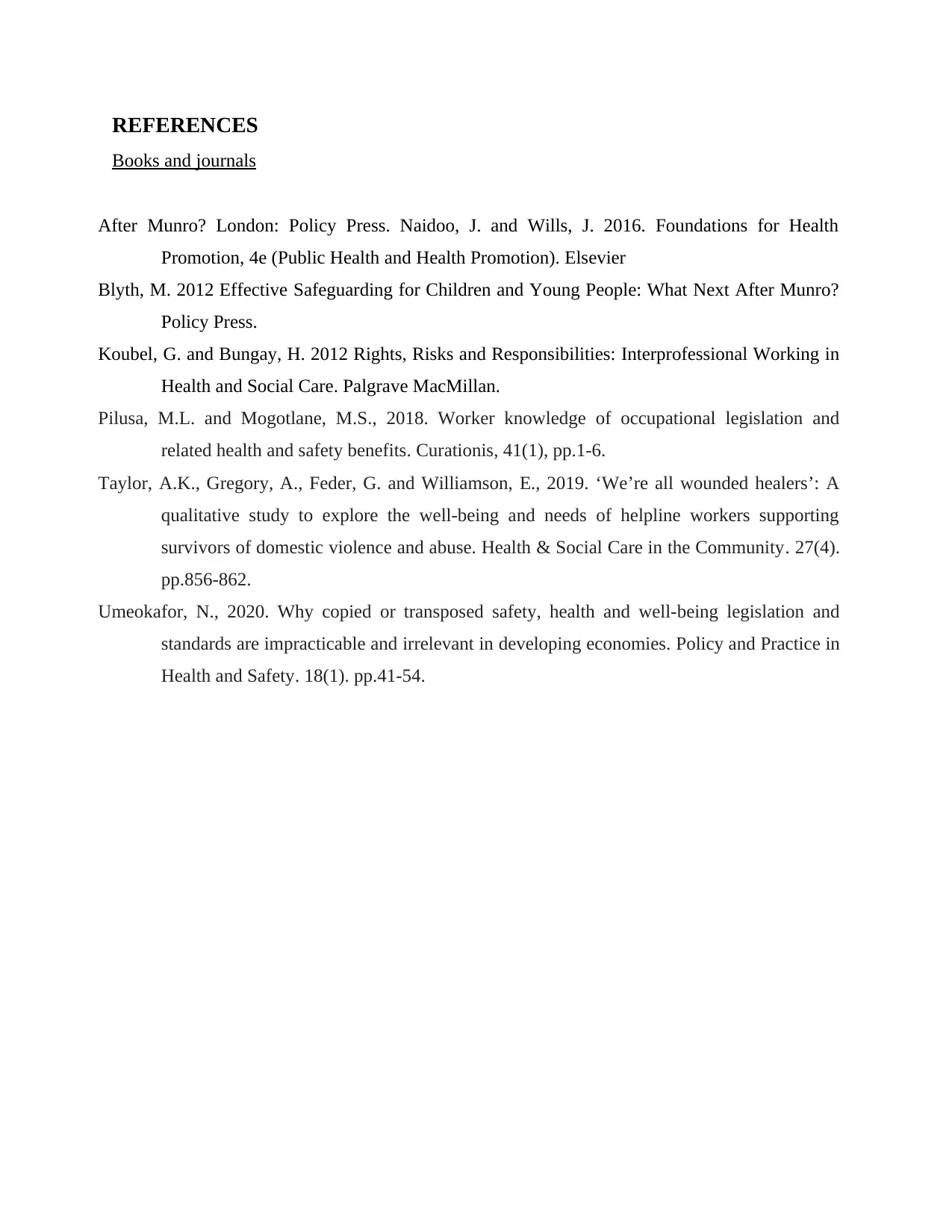
REFERENCES
Books and journals
After Munro? London: Policy Press. Naidoo, J. and Wills, J. 2016. Foundations for Health
Promotion, 4e (Public Health and Health Promotion). Elsevier
Blyth, M. 2012 Effective Safeguarding for Children and Young People: What Next After Munro?
Policy Press.
Koubel, G. and Bungay, H. 2012 Rights, Risks and Responsibilities: Interprofessional Working in
Health and Social Care. Palgrave MacMillan.
Pilusa, M.L. and Mogotlane, M.S., 2018. Worker knowledge of occupational legislation and
related health and safety benefits. Curationis, 41(1), pp.1-6.
Taylor, A.K., Gregory, A., Feder, G. and Williamson, E., 2019. ‘We’re all wounded healers’: A
qualitative study to explore the well‐being and needs of helpline workers supporting
survivors of domestic violence and abuse. Health & Social Care in the Community. 27(4).
pp.856-862.
Umeokafor, N., 2020. Why copied or transposed safety, health and well-being legislation and
standards are impracticable and irrelevant in developing economies. Policy and Practice in
Health and Safety. 18(1). pp.41-54.
Books and journals
After Munro? London: Policy Press. Naidoo, J. and Wills, J. 2016. Foundations for Health
Promotion, 4e (Public Health and Health Promotion). Elsevier
Blyth, M. 2012 Effective Safeguarding for Children and Young People: What Next After Munro?
Policy Press.
Koubel, G. and Bungay, H. 2012 Rights, Risks and Responsibilities: Interprofessional Working in
Health and Social Care. Palgrave MacMillan.
Pilusa, M.L. and Mogotlane, M.S., 2018. Worker knowledge of occupational legislation and
related health and safety benefits. Curationis, 41(1), pp.1-6.
Taylor, A.K., Gregory, A., Feder, G. and Williamson, E., 2019. ‘We’re all wounded healers’: A
qualitative study to explore the well‐being and needs of helpline workers supporting
survivors of domestic violence and abuse. Health & Social Care in the Community. 27(4).
pp.856-862.
Umeokafor, N., 2020. Why copied or transposed safety, health and well-being legislation and
standards are impracticable and irrelevant in developing economies. Policy and Practice in
Health and Safety. 18(1). pp.41-54.
1 out of 11
![[object Object]](/_next/static/media/star-bottom.7253800d.svg)





